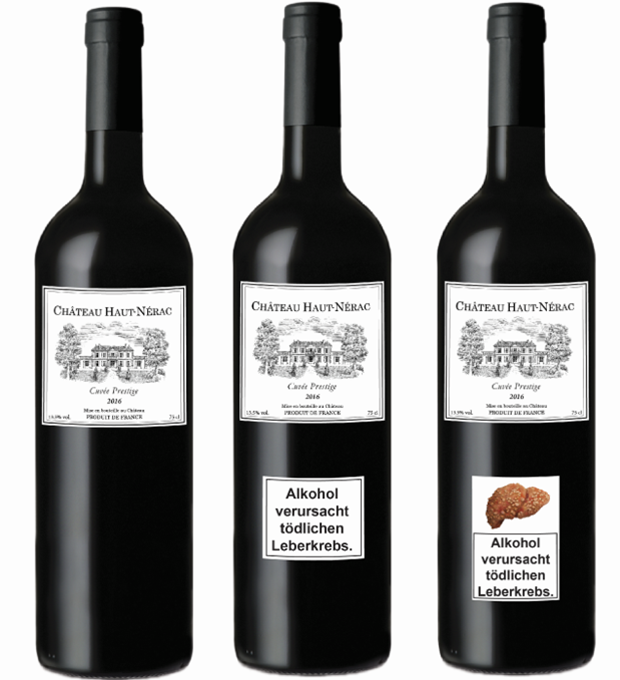By Cornelia Staub
Background
Drinking wine is an essential part of many countries’ cultures, especially in Europe. In countries like France, Italy, or Spain, the production and trading of wine represents an important branch of the economy and wine consumption levels are amongst the highest worldwide. Europeans do not only like wine, they also consume vast amounts of beer, and spirits. As a consequence, the total per capita alcohol intake is by far the highest in the European Region. On average, a person in Europe consumes 17.2 g of alcohol per day which refers to roughly one liter of beer per day per drinking person.[1] It is not surprising that such high levels of alcohol consumption are reflected in the numbers of alcohol-attributable diseases and the costs for public health.
There are several options for policy makers to address this issue. One measure to remind consumers of the health risk at the point of purchase and consumption are health warning labels (HWLs) like they are known from tobacco packages. There is an increasing body of literature that assesses the effect of HWLs on consumers’ reactions. Although some studies showed that HWLs can slow down consumption and evoke negative feelings in consumers, it was found that the acceptance to introduce such labels was low. In a region like Europe where wine has not only economic but also a cultural significance, it is likely that the support for HWLs is low. In the case of wine, a barrier for the effectiveness of such labels may be that wine is perceived to be beneficial to health.
Our study
Perceived risk is important to determine to what degree someone engages in a risky behavior like alcohol consumption. Therefore, we conducted an online experiment in Switzerland to test the effect of HWLs on perceived risk of drinking in a culture with a high affinity for wine. Furthermore, we wanted to investigate what role the widespread beliefs that wine consumption is healthy plays in this context and what factors have an influence on the acceptance of HWLs.
We found only a small effect of HWLs on participants’ perceived risk of consumption suggesting that they may not be effective in altering drinking behavior. Moreover, highly deterrent HWLs that depict a diseased liver additionally to the text warning ‘alcohol causes deadly liver cancer’, was not more effective than a simple text warning. The perceived health benefits from wine had a major influence on how risky someone perceived drinking wine.
We found that the acceptance for HWLs on wine is low, especially in the form of an image-and-text warning. We found that participants see no need in including such warnings on wine bottles. This was due, on the one hand, to the perception that moderate wine consumption is healthy. On the other hand, we found that participants who oppose government interventions to restrict individual rights in general, are not in favor of depicting HWLs to warn consumers of the potential harms of alcohol consumption. The study showed that the success of HWLs to reduce drinking behavior may be limited in countries where drinking wine is part of social norms. Furthermore, we were able to show that the lack of perceived risk from consuming wine was strongly affected by the belief that moderate wine consumption is healthy.

What’s next
Despite there being potentially positive effects of drinking wine in small amounts, such convictions may not favor responsible drinking behavior. The levels of alcohol consumption are increasing worldwide except for Europe. Although this may be a positive development for Europe, it is important to keep in mind that the consumption levels today in most European countries are far from moderate. A number of governments introduced some sort of warning on alcohol containers such as warnings for pregnant women. The existing labels are often criticized for their negligible size and the lack of effectiveness. Our study showed that even highly salient HWLs may not be sufficient to call for moderating one’s drinking behavior. The effectiveness of the labels we tested in our study may be different in a real-life scenario. For example, if consumers face a shelf full of wine bottles with warning labels, this may nevertheless raise their perceived risk of drinking wine. A measure like HWLs on wine bottles is likely to be confronted with considerable opposition from consumers but especially the alcohol lobby. Notwithstanding the (lack of) effectiveness of HWLs, public authorities should address the issue by correctly informing consumers about the risks of alcohol consumption and emphasize that not primarily the beverage type but rather the amount consumed is decisive for the consequences of alcohol on one’s health.
Read more at: https://www.sciencedirect.com/science/article/pii/S0950329321003177

Cornelia Staub
Consumer Behavior Group, ETH Zürich
In my research, I focused on consumers’ perception of wine and beer and how this affects their purchase and consumption behavior. I have a Master’s degree in Agricultural Economics from ETH Zürich and worked in wine production and trading before starting my dissertation in consumer behavior and alcoholic beverages.
References:
- World Health Organization [WHO]. (2018). Global status report on alcohol and health.
[1] It is estimated that 40% of Europeans do not drink alcohol. See, WHO. (2018). Global status report on alcohol and health.

